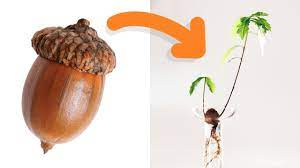Cultivating an oak tree from seed is a deeply fulfilling and environmentally conscious activity. It fosters a connection with nature while offering a meaningful way to contribute to the planet’s well-being. Revered for their longevity and majestic beauty, oak trees play a crucial role in supporting ecosystems and combating climate change. This article explores the compelling reasons to grow an oak tree from seed and provides a detailed guide to help you embark on this rewarding journey.
Benefits of Growing an Oak Tree from Seed
1. Ecological Importance:
Oak trees are foundational to many ecosystems, offering shelter and sustenance to a wide range of wildlife, including birds, mammals, and insects. By growing oak trees from seed, you help restore natural habitats and support biodiversity, ensuring the balance of local ecosystems is maintained.
2. Enduring Legacy:
Oaks are celebrated for their incredible lifespan, often thriving for hundreds of years. Planting an oak tree is an investment in the future, providing shade, beauty, and ecological benefits for generations to come.
3. Climate Resilience:
With their adaptability to various climates and soil conditions, oak trees enhance the resilience of forests. Their ability to thrive in diverse environments makes them a crucial ally in the fight against climate change, supporting ecosystems as global temperatures shift.
4. Carbon Sequestration:
Oak trees are highly effective at absorbing carbon dioxide, making them vital in reducing greenhouse gases. A mature oak tree can store significant amounts of carbon, directly contributing to the fight against climate change.
5. Educational Opportunities:
Growing an oak tree from seed offers a hands-on learning experience for individuals, families, and communities. It provides valuable lessons about ecology, tree life cycles, and the importance of environmental stewardship.

Step-by-Step Guide to Growing an Oak Tree from Seed
1. Collect Acorns:
Find acorns during the fall season. Choose mature, undamaged acorns free from mold. Testing their viability by submerging them in water—discard those that float.
2. Prepare the Acorns:
Carefully remove the outer shells, preserving the inner nut. Discard any acorns that appear cracked or compromised.
3. Stratification:
Mimic the acorns’ natural overwintering process by placing them in a plastic bag filled with damp peat moss, sand, or vermiculite. Store the bag in the refrigerator for 2–3 months to break the seeds’ dormancy.
4. Select a Planting Site:
Choose a sunny location with well-draining soil. While oaks can adapt to various soil types, they thrive in conditions that allow deep root growth.
5. Plant the Acorns:
In the spring, plant the stratified acorns about 1 inch deep in soil, leaving several feet between each. Water gently and consistently, ensuring the soil stays moist but not waterlogged.
6. Protect Young Seedlings:
Use protective barriers to shield seedlings from pests and herbivores such as deer and rabbits.
7. Exercise Patience:
Oak trees grow slowly, taking years to reach significant height. With time and care, your tree will become a resilient and majestic addition to its environment.
8. Transplanting (If Necessary):
If the seedlings become overcrowded or require relocation, carefully transplant them to avoid damaging their roots.
Conclusion
Cultivating an oak tree from seed is more than planting a tree—it’s an act of environmental stewardship and a gift to future generations. Through this process, you’ll contribute to biodiversity, combat climate change, and leave a legacy of strength and endurance. Whether you’re an experienced gardener or a beginner, this journey connects you to nature in a profound way. So, gather your acorns, follow the steps, and watch your oak tree flourish as a symbol of hope and resilience for years to come.
This revised text enhances clarity, adds informative details, and aims to leave readers feeling inspired and educated about the process and significance of cultivating oak trees from seed.
